 Vol. 3 CONTENTS
Step 8-1-01. Four elements that determine the nature of an object
Step 8-1-02. The relation between the elements and the layers, additional
Step 8-1-03. To depict layer 2, you need to be careful ofthe relation between
Step 8-1-04. What kinds of memories am I able to suppose, that we have for
Step 8-1-05. Really, What is it, our whole image in our brain as a eyesight?
Step 8-1-06. Why are we able to quickly recognize the whole visual field
Step 8-1-07. By the quick recognition about the view and by the nature
Step 8-1-08. I think I need a supplementary explain about C.R.Image and
Step 8-1-09. the tale of Mr. Brain and his C.R.Image & S.R.Image, additional
Step 8-1-10. the tale of Saint Jerome, his fame and his misery, additional
Step 8-1-11. a apple and a realism painting, additional explain for C.R.Image
Step 8-1-12. We aren't carefully seeing in our usual demands, and we never
Step 8-1-13. a windowpane, additional explain for C.R.Image and S.R.Image
Step 8-1-14. a simple experiment for C.R.Imag and S.R.Image
Step 8-1-15. I mention again my conclusions about the recognition
Vol. 3 CONTENTS
Step 8-1-01. Four elements that determine the nature of an object
Step 8-1-02. The relation between the elements and the layers, additional
Step 8-1-03. To depict layer 2, you need to be careful ofthe relation between
Step 8-1-04. What kinds of memories am I able to suppose, that we have for
Step 8-1-05. Really, What is it, our whole image in our brain as a eyesight?
Step 8-1-06. Why are we able to quickly recognize the whole visual field
Step 8-1-07. By the quick recognition about the view and by the nature
Step 8-1-08. I think I need a supplementary explain about C.R.Image and
Step 8-1-09. the tale of Mr. Brain and his C.R.Image & S.R.Image, additional
Step 8-1-10. the tale of Saint Jerome, his fame and his misery, additional
Step 8-1-11. a apple and a realism painting, additional explain for C.R.Image
Step 8-1-12. We aren't carefully seeing in our usual demands, and we never
Step 8-1-13. a windowpane, additional explain for C.R.Image and S.R.Image
Step 8-1-14. a simple experiment for C.R.Imag and S.R.Image
Step 8-1-15. I mention again my conclusions about the recognition

Step 8-1-01
 our elements that determine the nature of an object, the additional explain
our elements that determine the nature of an object, the additional explain
I say again, there are three kinds of object for our visual objects
First is constituted by the clearly recognizable
elements
Second is constituted by the clearly recognizable
elements and the not clearly recongnizables.
Third is constituted by the not clearly recongnizable elements.
If I examine that nature, I think I may conclude that what kinds of object
it is, is determined by the location which layer the object is belong to.
If the location determined the nature of an object, the distance between
our eyes and the object might determine the nature.
By the way if I examine what elements determine the nature of an visual
object, I think I can determine or express an visual object by the four
elements below.
1. the out-line
2. the mass or details
3. the texture or the condition of surface.
4. the color
1,2 and 4 are difinite, but 3 needs to be
explaned clearly.
And I think I can say that those four elements will be able to be recognized
on the particular location clearly for the four all elements, on the other
location only for the one element clearly and the other three obscurely.
Namely, I guess the recognition of the four elements are depend on the
location, which layer the object is belong to.
I think I may conclude that the recognition of an visual object is determined
by the four element and the location.
1st element;
Imagine a perfect circle, drawn by a compass.
Then the object has determined one elements, the out-line.
if you didn't draw any line in the circle, then I can say as one possibility
that the object is to be determined 3rd element, the texture, that can
be very smooth surface, judged by our experience, because there is no information
about the texture,
at the same time I can also say that it is a circle, just as a geometrical
object.
I might say that which judgements is correct, will be depend on the environment
of the object. If I haven't any environment, then I can say that the both
judgement are possible.
2nd element;
Next, imagine that you painted out one side of the circle for a crescent shape,
Then that is to detemine 2nd element, the mass, we understand it as a globe,
becaue we know that a globe has that shade under a particular lighting,
but we can't judge it truely whether it is a globe or it is just a plain
circle that has a detail, crescent-shaped pattern as well as the above
mentioned case.
Both are the same thing for our image, without another point of view, or
another sense, unless we touch it with our hands.
So I said that 2nd element is the mass or the details.
Well, How about this question?, Since when have we understood Moon as a
globe? Did European do it before 17c? For, the question is interesting
for me at the point of the same condition with the above mentioned examination.
Moon floating in space far distance offers only two element, like the above
mentioned examination, i.e. the out-line; circle and the crescent shade.
If the Moon is on the something flat base, within its environment, then
it casts its shadow on the plain. It will give another evidence about the
Moon, object about the shape.If the shadow is also a circle, then it will
be a globe, if it is ellipse and changes it shape according to the lighting,
then it may be supposed as a plain circle.
But we have only two element about Moon, as we see it our eyes from far
distance.
So, we can't determine the nature of Moon, if we didn't have the knowledge
about it.
Actually, we can't still do it without a telescope, but just believe it
by the authority of science that has shown its practical power in the technological
and also the battle field.
As far as we see it by our eyes, from far distance as a visual object without
touching it, we may say it a circle, also a crescent, but we can't determine
its nature as a globe.
A telescope will offers the 3rd element, the condition of surface, then
we have another evidence that determines the nature.
3rd element;
Next, Oh! it is difficult to imagine the 3rd element, texture or conditon of the surface.
But, imagine it as the dimples like a golf ball, or rough texture like cloth within the circle, if you can.
Namely, I think I may say that the details will offer some evidence about
the mass, and the mass will have an effect on the details, or we cannot
help judging like that by our nature of understanding, that may lead us
sometimes to false conclusion, and that is the matter of painting, if the
expression can stand for another sensation, touching, then it will be a
sculpture.
We might see the changing patern of the dipples from the center to the
outer, or the unchangeable patern.
If each dimple is same appearance each other within the circle, then the
circle is suppose to be a plain circle with the dimples.
If each dimple is changing to an much oblonger ellipse according to the
location from the center to the outer, then the circle is supposed to be
a globe, but it still remains as a possibility as far as we only see it
as a visual object.
Likewise, we are gradually determining much more decisively the nature
of an object according to get much more element, evidence.
4th element;
Really, 4th element, the color will have an effect on false information
about 2nd element, the details or 3rd element, the texture, and there may
be influence between the details and the texture.
So the color can be said as not so the independent element as the other three, but undoubtedly, for everyone, the visual object has color.
As I need to simplify the model not to confuse the examination, so I don't
mention it further.
Except 4th element, the color, those three elements correspond with the three layers, I assert
The 4th element, the color also obviously corresponds with the three layers,
i.e. the color of the object in the same condition will be fading away
according to the distance between our eyes and the object, for example,
the croma of object on layer 1 is brighter than on layer 3.
But the 4th element, the color is more or less found out on the all layers for, conceputally,
the continuously changing value. So the 4th element, the color is not so the decisive element to determine the nature of the visual object for the following examination.
For, it is possible that the same categoized object has the different color,
for example, a red apple and a yellow apple, and the same sky will be fine
and also cloudy as a visual object.
On this point of view, the 4th element, the color is the intuitively effective
element to sort the same categorized objects to each an individual.
An object can have the several different 4th elements as its attribute
for the paticular condition.
So it isn't an essential element for our recognition for the visual sight,
about what it is.

Step 8-1-02
 he relation between the elements and the layers, additional explain
he relation between the elements and the layers, additional explain
I think that the relation between the elements and the layers are simply
explained below.
Layer 3 has only one element, 1st element,
or only 1st element is clearly recognizable
on layer 3.
Layer 2 has two elemnet, 1st and 2nd element,
or two elements are clearly recognizable
on layer 2.
Layer 1 has three element, 1st, 2nd and 3rd
element, or three elements are clearly recognizable
on layer 1.
Namely, much more nearer an object is coming,
much more elements to determine its nature
it has.
By the above examination, I can say that the most essential element for
our visual recognition is the 1st element, out-line, that is active on
far distance. We can affirm it by the fact that we can understand the object
even by the very simply drawing, cartoon, we can understand what it is
or what it means, and the out-line is the rather conceputual, symbolic
figure.
And the three layers correspond with former
mentioned three kinds of object.
By the way, we are to be aware of that we found out the same conclusion
about our recognition with Hume by the examination about the four element
that determine the nature of object.
That is that we possibly determine the nature of the visual object by fewer element, at the same time we can determine much more decisively the nature by much more element.
We are really doing the both.
However our recognition about the world doesn't only contradict with the
other sensations, hearing, touching, etc, but also is much more exactly
determined by the other sensations, however our recognition about the world
dosen't only contradict with the other ego's, but also is much more exactly
determined by the other ego's, we can never know the further recognition
beyond our sensations through an indivisual sensation, an ego, just mine.
That is the same thing that I menetioned about the straight line, however
the exactly straight ruler it is, we see it by our eyes, then it will be
curved in our peripheral eyesight.
So our recongition about the world still remains as the probability, 'It is
probablly the same thing as we exactly see'.
Is it possible at all that we recognize beyond an indiviual sensation,
an ego?
To return the method, how to draw layer 2, so you have to depict an object on layer 2 with not only the out-line, 1st element but also the mass or details, 2nd element.
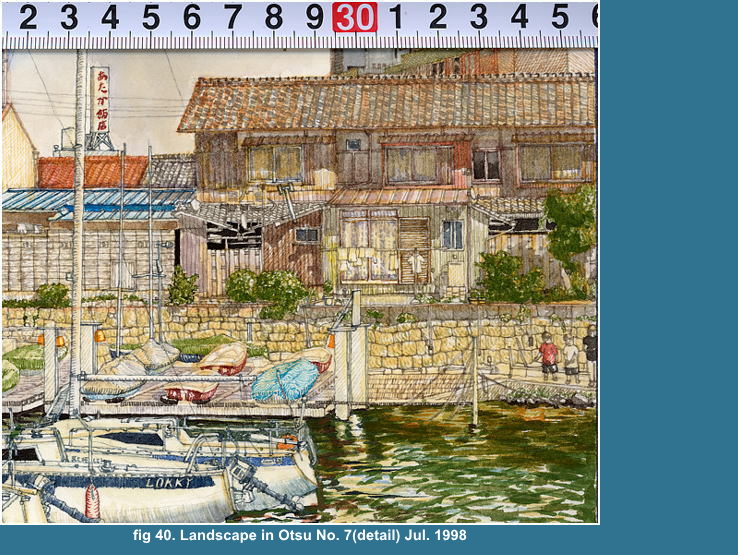 See fig 40
See fig 40
See the dike piled up with stones.
I depicted those stones with yellow hatchings,
probably, cadmium orange and gamboge to make
feel its undulation.
Can you see it?
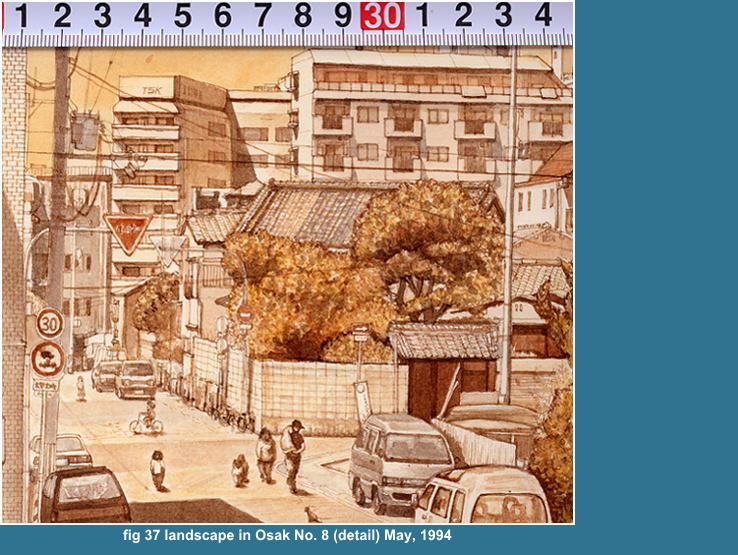
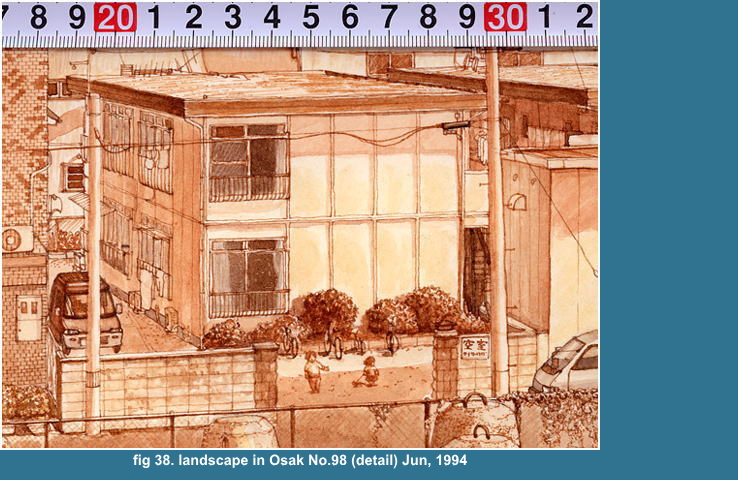
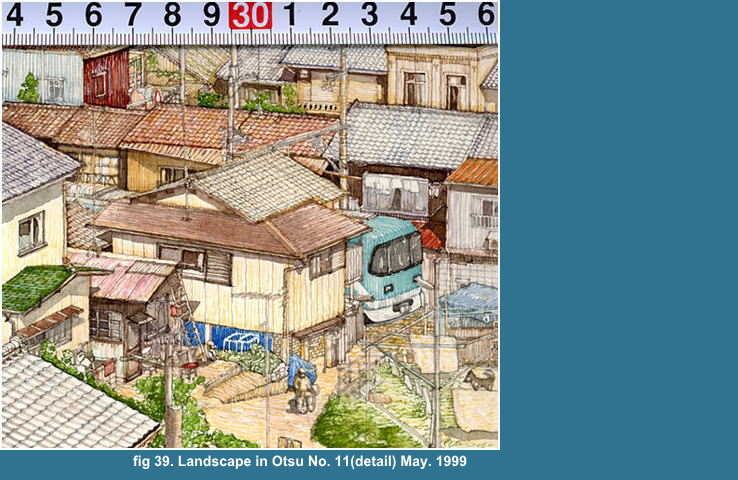 See fig 37, 38, 39
See fig 37, 38, 39
I depicted the details of houses, the arrangements
of those, windows, roof tiles, covering plates,
wood, new kinds of building materials. Those
arrangements naturally determine the nature
of the mass or cubic, what kinds of cubic,
the relation of each side.
And I colored those detail with color lines,
color hatching to keep the brightness, and
used wash only to make the effect stronger.
If you finish your watercolor for monochorme, then you can unify easily
the value of brightness.
But when you finish it for full color, then each color itself has the different
value of brightness and the coloring sometimes darkens your water color
and cofuses the unity of the value of brightness, so you may need any solution,
and the color hatching is one of the solutions.
What you do for the object on layer 2 is only to depict the inner part
of that out-line mesured on Step 6, and is the same thing to depict the
smaller object on layer 3.
The object now has clearly shade and shadow for a particular lighting, and you can feel vaguely the texture, what material is the object made of?
Or you have the knowledge about the material by your experience, even though
you can't feel it by observing.

Step 8-1-03
 o depict layer 2, you need to be careful of the relation
between your stocked knowlegde and your observation
o depict layer 2, you need to be careful of the relation
between your stocked knowlegde and your observation
But you have to be carefull of your knowledge. That knowledge is sometimes
to be an obstacle to the realistic expression, cause of the idealistic
one, or the conceptual one, or a child picture.
I have said that you need to express the object by the words to clearly
understand it.
But it is that the important thing is to replace it by the words what you can observe, or you are seeing, not to do it
by your stocked knowledges
We know what shape a house is,
what shape a human body is,
what shape a tree is, etc.
But these are our knowledge, concept, idea, like an object that has only
1st element, out-line.
If it is the object on layer 3, then it may be sufficent.
But now we are going to draw layer 2, then we need also to depict the 2nd element, then we need to know only
what it is but also
how it is.
The 2nd, 3rd, 4th element is to depict nothing but to depict how it is.
We are apt to replace an object by the words
without observing, especially it happens
when we well know it as a familier or very
common thing.
A child painting is a typical conceptual
art.
He paints and expresses a man not as what he is seeing but a symbolic figure,
like a human has a head and body,
hands and arms and legs,
a head has hair, eyes, eyeblows, etc.
He will describe those and put in particular arragement, that we don't
think real human figure as a visual recognition, but rather symbolistic,
however we can understand it, and communicate with him by it.
I can suppose that you usually say a child painting as a very free one.
But I think his painting too much depends on his knowledge what a human figure is, bound on a concept, not free.
Namely, he is just starting to get and accumulating his idear on first
step about the objects surrounding him, so the contents aren't still filled
up.
And his enjoyment is only to paint, and it's never how to paint, or what he paint.
And a child can't compare his painting and his object, even though he had
an object.
As he enjoying his painting, his painting is simple, but delightful one. But, needless to say, it doesn't mean that all child paintings are delightful.
Imagine a ordinary boy, age 10 to 15teen, even 18teen doesn't like painting
and hates art, he has to paint in his art class, then he will relactantly
paint a typical childish painting.
When he paint a tree, then he choose a viridian to paint leaves, why?, because the leaves' color is green, and there is a painting material, tubed green color, probably it is viridian.
His choice is just based directly on this
knowledge" a leaf is green color"
not the result of comparing his choiced color
and his observed color.
Indeed, he is looking the tree, but he looks nothing but his idea, a concept of tree, just a symbol.

Step 8-1-04
 hat kinds of memories am I able to suppose, that we have
for the stocked visual images in our brain?, additional explain and my
hypothesis
hat kinds of memories am I able to suppose, that we have
for the stocked visual images in our brain?, additional explain and my
hypothesis
I suppose that situation about our recognition
like below.
We stock in our brain an visual object by
replacing with LIKE A WORD, I don't know
exactly it but I say it to explain, like
a computer stocks the data by binary number,
0 and 1. As we can understand a computer
need many memories to stock the visual image,
we can't stock a visual image as it is, but
only it by the idear, or concept, for it
has too much details.
The quantity of the information, details constitute the idea correspond with our special interest or our work.
A painter has many information, knowledge about a visual object, probably,
should, by his experience. But he has just a common idea, knowledge about
the another things as the ordinary people.
I suppose we are probably dealing with our life by the collection of common
ideas, I say it by another word, the stocked object by "out-line"
without details, as I mentioned as 1st element.
We can do it by that for the object on far distant, layer 3, because it
won't damage or be harmful or threaten our life for its far distance.
We don't mention it and we don't need the informaiton about it.
It isn't our interest.
For example,
A driving car in far distance is never danger, we need to recongnize it
no more than that it is a car moving in far distance.
I don't mean that an object in far distance
appears to us as an image on our retina just
like a out-line, but the object seems to
be stocked as data or temporary memory like
a out-line in our brain lasting for a while.
It's no doubt that we have an image like a photograph on our retina. But
I guess that we aren't acturally watching simultaneously or at real time
over all the parts, details of our image on our retina, but watching one
part by one part ( it doesn't mean exactly one cell by one cell ) , like
scaning each part by turns, or like a computer chip excecuting a program
cords step by step.
I suppose you ask "Then, Why can we
keep the whole image for our view?"

Step 8-1-05
 eally, What is it, our whole image in our brain as a eyesight?,
eally, What is it, our whole image in our brain as a eyesight?,
I think it is false that we have always clear whole image like a photo,
and we just believe it or judge it so, I explain it by the example of a
bookshelf, additional explaing and my hypothesis.
It can be easily answered by my hypothesis below.
Our brain can keep each part of image for
some duration of time. The ability is same
as the our sense to the movie, each one frame
of the films is an image of a stoped figure,
but we sense it as smooth motion by threshold
value of frame speed, by afterimage.
A lens of our eye is probably almost same
as a lens of camera, that means that we can't
focus simultaneously near object on 30cm
distance and far object. You can confirm
it by very simple experiment; How are you
see the far distant image?, when you are
focusing on an object on 30cm by only one
your eye and shut the other. Really it will
be out-focused.
But I suppose we don't usually sense it.
Why?
I suppose that one reason is that we have two eyes, the another is that
we are constructing our whole image by collecting up with each parts of
clearly focused image. If we see carefully one object, then we are to focus
on that object without conscious, and that is our nature.
I think we aren't aware at all that we are always preparing to focus on
something and have already focused, like automatic camera. And that each
action, one scaning is very quickly achieved in the duration of particial
afterimage in our brain, like a program goes back to the first step of
cords, when it have excecuted the last step of cords, I suppose. So we
can have clear, pan-focused whole image.
Certainly, we can see the whole view, not
focusing on particular detail, and that appears
as a clear view?
For example,
you can experiment it like below.
You are standing in front of bookshelf, and you can see many books on it
neatly, and you can read clearly the title of every book on the spine.
I suppose you can't read the tilte without
focusing on a spine, that means you can't
be clearly awaring of the surroundings when
you are reading through the title.
I think you have been convincing that you are keeping the whole view with
the details, the image of the every books with the every clearly readable
title on the spine, the whole bookshelf, even when you are reading over
the title.
But that judgement that we have the clear whole image is probably false, I think.
Probablly, it is that we have a clear image of a title and the vague image of surroundings, we merely believe, or know that
the surroundings are also fiilled up with the details by the former experience.
And that recognition about the surroundings is the compound recognition
mixed up with the recognition by the real vague image and the recongnition
by the memories that provide us the insurance about the existence of the
details while we aren't really focusing on, I suppose.
But we don't know really its being at that moment whether it is as its had been or not.
But we usually
judge its as its had been.
We judge its so by the continuity, like John Locke says? or Hume, we judge that
the world had been existing as same as the yesterday, while we were sleeping, and that is the same of the yesterday, when we have waked up.
And we can have focused quickly on one details to another.
And we can't judge clearly it whether the surroundings are really clearly
recognized or not.
Because we can't judge clearly what we obscurely recognize, also like John
Locke, "it is impossible to be at the same time not to be."
We can understand the situation much more
clearly by the example, that is when we are
reading a book, we can't read simultaneously
the plural lines, or you can?
It is definite, but we seem, certainly, to be able to understand simultaneously the plural visual objects?
But, Why?

Step 8-1-06
 hy are we able to quickly recognize the whole visual field,
and why aren't we able to quickly read? , additional explain and my hypothesis.
hy are we able to quickly recognize the whole visual field,
and why aren't we able to quickly read? , additional explain and my hypothesis.
Reading is to understand the meaning by the permutation of the characters.
We can't understand without seeing the characters, that are the details
of the printed pages, and I think it definite, that we aren't care of another
line, another details, while we are seeing one line, one line of details.
To read is to dertemine the meaning, that
need to have read one word, one sentence
by reading one character by one, and the
word's meaning is different by one character,
right?, "light" is different word
from "right".
Of course, we will be able to guess the meanig of one sentence by only
one or two word, for a typical conversation by mediocartive person, or
typical official statement by official, even more, for extremely situration,
we can guess the whole statement of an government official without hearing
it by our experience, and as a result, we probably find that our guess
was correct.
On that situation, Reading is constuted by the real-time recognition by the permutation of characters
and the recognition by the memories about the stock of typical conversation for a particular situation.
The reading speed must be depend on those stocks of typical conversation,
the reason why I can't read quickly the book writen in English is roughly,half
by that reason, and the other half is that the writing itself is new, interesting
for me, that is the same for in English or Japanese. Much more new and
interesting a book is, much more time we need to read thruough it. That
means that we can't skip the sentenses by our expectation.
I think these constitution about Looking and Reading is almost analogical
about that recognition,
that a recognition about Looking and Reading is constituted by two kinds
of recognition, that are a real-time recognition and a experienced or stocked
recognition.
We are judging an object by that recognition mixed up with two kinds recognition,
and so we sometimes misunderstand to much depend on the experienced or
stocked recognition.
And it is the important point of view.
Why can we quickly understand the whole visual field,
why can't we quickly read but only one sentence by one?
why can we understand much more quickly an image than a word?
A reasoning, why can we quickly understand the whole viusal field, that
I suppose it below.
The objects that constitute our visual field
are two kinds of objects, one is the object,
not moving or not changeable, or very slowly
moving or very steadily changing, and the
other is the object, moving, or quickly chainging.
We have an idea about our world, our space, that is probably expanding its image
by our experience and our knowledge that can be agreed by us, our rough guess by our limited experience.
Our world might be small when we were child, that might mean no more than
the neighbourhood. Acturally, we need not know much more than the ground
and the sky, mere the phenomenon of weather for the visual world.
A scientist talking about the Universe by The Big Bang Theory, honestly
speaking, I think the theory is more or less as a good competiter as my
this reasoning about the recognition, though people admire the theory is
science and laugh at my reasoning as boasting.
We need not mention the theory at all, even if the universe was expanding
at tremendous velocity, we probably recongnize it as a motionless object.
Our directly caring is the chainging of the thin, very thin layer of the
atmosphere above our head.
Anyway, Our world, the surroundings, visual objects in our visual field
can be usually expected their near future, are slowly and steadily changing
by the whole view, that means that we can use or apply our experienced
or stocked memories to the recognition about our visual field, present
and near future.
We may usually check only about the points, that have chainged and been different
from those near past images in our brain that we might have the equivalents with our visual field.
And those process of checking, or recognition will be very quickly achieved,
for we don't need to recognize every details of all the objects in our
visual field, but just check their out-line quickly through over the field.
By another expression, it is just the same as that we are reading only
the title of the books on the shelf that we have read, we know by our experience
those contents are never changed, and we need only to read an unknown book
on the shelf.
So I suppose that we probably recognize and
have, in our brain, the clear real-time images
filled up with details only for the object
that we concentrate our attention on.
And I suppose like this, that we are re-reading, by scaning in particular
interval, only the out-line elements, contour, color, shade, etc without
details about the image of the other objects, the surroundings, the once
attentioned object.
Also I suppose that the images of the surroundings in our brain are no
more than the images of our dream or have the same nature, vague and strange
without definite details.
As I suppose above that the surrounding images may be mainly built up with
the experienced or stocked images, we may only be checking whether the
suroundings remain as its being near past or not, like checking a title
and may be newly re-written over.
I think the difference between the images of surroundings and the dream
is whether the image are corrected by the re-reading-and re-writing or
not, the images of a dream aren't corrected by the re-reading and re-writing
of real sight, for we aren't watching while we are sleeping. So the once
written images may be deformed or combined with another one at random during
its are fading away, that is the cause of the strange image of our dream,
I suppose.
The process of dream will be thought like
below, I guess.

Step 8-1-07
 y the quick recognition about the view and by the nature
of the images of our dream, I cannot help concluding that our images are
categorized for two kinds of image, that I name its, C.R.Image and S.R.Image,
additional explain and my hypothesis.
y the quick recognition about the view and by the nature
of the images of our dream, I cannot help concluding that our images are
categorized for two kinds of image, that I name its, C.R.Image and S.R.Image,
additional explain and my hypothesis.
We begin to read an image from our experienced or stocked memories in our
brain by the cause of something, maybe, sensation about sound or touch
or even a stocked image except about real sight while we are sleeping.
The choice must be happened by an accident, or last memoies of the day or clearly impressed one may be expected to be easily choiced as Freud says.
But the images have been read on particular part of cells of brain will be vanishing by a particular physiological process without re-written,
like an image is naturally fading away when we shut up our eyes, if any new sensation that activate the image on the brain doesn't happen.
When we are awake, then we are usually sensing and looking around the circumstance,
that is the action of re-reading about our sight and re-writing about our
images.
But when we are sleeping, then our brain isn't under the controll about
re-reading and re-writing of our images. Our brain may read the experienced
or stocked images by active sense, while we are sleeping, and write at
random a particular part of whole our images, and those newly written images
itselves may cause another sensation, and the sensation may happen another
reading, and the reading may write at random another part, etc.
Those process that I suppose as a dream's process without checking with
the re-reading an re-writing by sensing the actural eyesight is the main
reason of the strangeness, I think.
When we are awake, then we can correct our image by wholly active senses,
looking real sight, hearing sounds, touching the object, moving and changing
our position and comparing it with our image for above mentioned each step
of the process.
When we are sleeping, then the remained active
senses are automatically dealing with the
process by the particular logic, probably
by the active sub-routine process, I suppose.
What I suppose and mean as "sub-routine process" is the process
that doesn't need any intentional and definite order by thinking brain,
but controls a typical routine action, like walking, that we need not order
and control our legs how to move it to walk.
That example is the matter of cerebellum, but I show you it, for it is
very easy to understand.
I think I may suppose many sub-routine processes between our sense and
our process building up an image.
Really I have had very long roundabout route to explain my foundamental vision about an image on our brain.
And, of course, I don't have any scientific proofs about my explain and
I think it's nothing but a fancy by myself. But I think we can still do
it with the method like John Locke 17c about a phenomenon of our mind.
And a science is still poor method about that phenomenon.
By the way, I think Freud's theory is interesting but almost fiction and
fantasy, though he says his theory is science and true. In addition, I
have an opinion about a mental diseases, that pshycoanalysts deal with,
except slight, so to call a depression, are better understood not as a
phenomenon of pshyco-dynamic but as a functional disorder of our brain.
So I may proceed my explain by the method with my own experience, for I
am not going to say it neither truce nor science, but just do it for my
plesure of researching.
It is undoubtable and definite that the images of a dream are constructed
by our experienced or stocked memories about images.
We usually think our dream is strange, but I think we are never doubting
the reality of the image, that has many details as the same as what we
are seeing while we are awake.
But I doubt, it's exactly so?
I need the further examination about the images of a dream or the images
mainly constructed by the experienced or stocked memories about images.
I'm going to give name to those two kinds of image, that, I suppose, construct
whole our image as I have mentioned.
1. Concentratedly Recognized Image in our
brain, C.R.Image
2. Supplementarily Recognized Image in our
brain, S.R.Imge
1. C.R.Image is always at the state of the real-time re-reading and re-writing,
and watched closely for whole part, the out-line and its details in it,
all that the brain or our consciousness has to check.
2. S.R.Image is at fewer the state of the
real-time re-reading and re-writing than
C.R.Image, and that the re-reading and re-writing
are only excecuted about the out-line of
the images only to check the identity and
the relation to C.R.Image,or whether they
changed or not.
The ratio between C.R.Image and S.R.Image
will be changed by their importance.
The example below are seemed to be occupied by C.R.Image for the high ratio.
We are seeing nothing but one sentence or
a page of a book, when we are concentrating
to read it, though we keep the same visual
field of our eyes, much more than 180 degree
for width.
It's no doubt that the image on our retina is much bigger than the page.
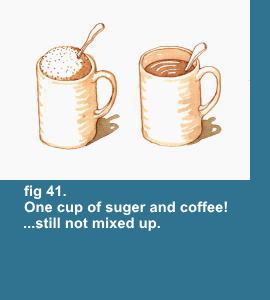
I suppose that C.R.Images and S.R.Images
are usually mixed up and construct the whole image. I mean, when we see a landscape, then each
C.R.Image and each S.R.Image are equally distributed in same density for
every part, like well mixed up one cup of the suger and coffee. Namely,
sometime C.R.Images are concentrated on an object and S.R.Images are on
the surroundings of the object, each may be separatedly distributed, especially
when we are fixing our eye on an object.
Sometimes C.R.Images and S.R.Images are equally mixed up and distributed
on the whole our image.
It's no doubt that Our image in our brain usually isn't exactly the same
thing as our image on our retina.
You can understand it really by a simple experiment, that we keep a standing still vision of the world,
even if we looked around and moved our eye right to left, up and down, the horizon appears to keep on the same position.
The world that we see never changes its position even if we turn around our head.
Namely, we never think it as the earth has changed its position, but we
have moved.
But the delusion may happen for us, that
is,
when we are on a train stopped at a station,
when we are suddenly aware of the moving
of another train side by our train,through
the window, that begins to move opposite
direction, then we might sometimes feel that
our train begin to move.
Namely, we know the earth is an absolute standard for ordinary life, then
the horizon appears stand still, even though the position of image of the
horizon on our retina changed.
But we know that our train may move as well as another one, then we need
to time to judge which train starts to move, until we find out the absolute
standard, the structure of the station, especially when we have lost the
former situation, experience, we are preoccupied with another thing, or
we are suddenly awake from doze.
We have many instances about those delusions.
Namely, we are constructing our image on our brain from the source of the
images on our retina, and everytimes we are renewing its by particular
procedures.
And the images on our brain are never being
sensed by equal concentration, and we can
categorize the images for two kinds, C.R.Image
and S.R.Image.

Step 8-1-08
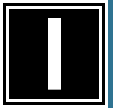 think I need a supplementary explain about C.R.Image and
S.R.Image to avoid misunderstandings.
think I need a supplementary explain about C.R.Image and
S.R.Image to avoid misunderstandings.
Imagine,
you are watching at four TV monitors, No. 1 monitor is a your favourite baseball or foot ball team's game,
No. 2 is the rival baseball or foot ball team's game, No. 3 is comedy, No. 4 is News report.
Then you must be watching concentratedly
at No. 1, though you sometimes watch only
for short time at No. 2. You may watch at
No. 3 during the commercial comes on No.
1 and 2. If No. 3 is boring, then you glanced
at No. 4. And you will be watching at No.
1 again, and repeat almost same procedure.
Then No. 1 monitor is C.R.Image and No. 2,
3, 4 are S.R.Image.
But when a shocking news comes on No. 4, then you must be watiching concentratedly
at No. 4.
This time, No. 4 is C.R.Image and the other are S.R.Images.
Namely, whether an image is C.R.Image or S.R.Image is not fixed on the
image itself, but is shifted by the priolity of the interest at that time,
or the demand of the information about each image. So an image will be
C.R.Image, and at the next the same image may be S.R.Image.
Our eye has the central visual field, as
a clear image on the centeral part of the
retina.
I don't know whether the faculty of our retina as a hard ware,a visual
cell concentrates on its center or not, but may be so.
But it's no doubt that we usually turn our head or our eyes to an object
that draws our attetion, namely we have a tendancy to set the object on
the center of our retina.
Namely we have a shot image at a moment, that is probably constituted by
the C.R.Image on the center of retina and as a result the S.R.Image on
the peripheral, that may also depend on the nature of retina, as the hard
ware as I mentioned above, i.e. by the distribution, that is probably the
high density of the visual cells on the center and the comparatively lower
desity of the visual cell on the peripheral, as a result the center image,
C.R.Image may provide the high quality images and the peripheral image
may provide the low quality images.
Thus our whole image being kept on our brain
will be constructed by the double constitution
by C.R.Image and S.R.Image. Namely, the whole
image seems to be constructed by C.R.Image
and S.R.Image, and its each part will be
also made up or re-written with many shot
images, that are constituted by the C.R.Image
and S.R.Image.
And we are always re-reading from our retina
and re-writing the whole images on our brain,
keeping or changing or replacing each part
of image as C.R.Image or as S.R.Image.
And this, just what I want to say, is that
we aren't usually aware of the existence
of S.R.Image. For we are always changing
or shifting or replacing part by part the
whole image on our brain by re-reading and
re-writing. So a vague image, I mean, S.R.Image
has changed already C.R.Image, when we were
aware of it.
Then you say "Why can you clearly insist
on the existance that we can't clearly recognize?"
The reason why I had mentioned about irrelevant-like
matter, a dream, is that.
Namely, we can clearly recognize or correctly to say it, judge who the
person in our dream is, but the image of the person may be vague one, for
we are just remembering it by our memories, and the quality of the memories
can be testified to draw it. If we can keep a clear image filled with many
details, then we can reproduce it like a photo only by our memories without
observing.
But we can't do it.
That, our vague or strange images of our deream, isn't the fault of our
painting techinque but our memories, I think, still we can judge it what
it is!
It's said that there are specific roles of areas on our cerebrum, speech
area, visual area, etc. So we may judge it, indeed we don't truely mention
about it whether the judgement is correct or not. I suppose it as the procedure
of judgement, identification that our brain connect a word with an image.
We have stocked many words on our brain, speech area and we may have also
images, probably simple, on visual area.
By the way, really do we have any stocked image? Indeed I can't make any
stocked image come up, even if I shut up my eye and imagin. But I can see
my dream while I am sleeping. That is probably the cause that we recognize
the BLACK OUT by shutting our eyes, we are still seeing the BLACK OUT,
while we are awake. So we can't see anything unless we stop seeing the
black out. By another expression, we have only one monitor in our brain,
and that is occupied now by the black out, so the monitor can't display
any stocked image. And I think we aren't seeing or ceased to sense by seeing
while we are sleeping.
Indeed I can imagine, I mean it's not like
seeing by eyes, vaguely the picture added
any effect or color or element or composition
without vision, but it's another subject,
I think.
So the judgement, identification is finished by connecting a word and an
image. While we are awake, we can connect correctly a word and an image.
But while we are sleeping , we probably automatically connect a word and
an image.
For as I have metioned about a sub-routine process, as we don't need
to order the motion to every muscle of our foot, to walk, we may just order the start
and the stop, even if we need to order. I mean the process between the start and the stop as a sub-routine process.
Although this is about the motions, we can suppose many sub-routines for our simpler recognition, judgement,
that needs not to newly examine and judge for everytimes, that we needs only to identify whether
the subject is the same thing as the precedents or not, if the subject was identified, then we may only apply the sub-routine.
The process of identification is the task of higher phenomenon of our mind,
main routine. When we are sleeping, then I may suppose the main routine
isn't active or particially, a fewer is active. And the sub-routines are
rather automatical process always waiting the order, the start and stop.
And some accident makes the manager once yell out the "start",
then the procedure will start and be finished automatically and display
the result and report to the active main-routine that the procedure was
completed.

Step 8-1-09
 he tale of Mr. Brain and his C.R.Image & S.R.Image, additional
explain
he tale of Mr. Brain and his C.R.Image & S.R.Image, additional
explain
I suppose the process of dream like that. And I think I may say that an
unconsciousness is mere the accidental excecution of the sub-routines,
if an unconsciousness were exisiting, and the process of identification
is rather random connecting without reasoning, likewise an superego must
be compare with the process of identification, so the dream is rather the
runaway of program. At the same time, I suppose those sub-routines are
gradually being constructed by our experiences, so the sub-routines will
reflect our personal history, that offers the possible interpretations
like psychoanalysis. But I can't trust it.
Psyco-dynamic neither has an effect on modifing our images, nor creat any image, I think.
Surely, if we had a strong emotions, we will usually keep its for several
days. Those emotions will be stocked on a particular area as we stock a
word. Indeed the strong and lastest emotions of the day may be existing
or active or suddenly activated by an accident while we are sleeping. If
the emotion was active, then it may call an image or a sound or touching
that are the stocked sensation, and those called sensations may move our
eyes by the sub-routines process.
When we identify an object, "This is a dog", then we need to
connect a word "dog" and an image "one head and body and
four paws and a tail" and barking "woo, vwon, vwon" and
particular motions and our particular emotion about a dog. We can correctly
connect those elements while we are awake and correctly identify it, but
we can't do it while we are sleeping.
Above mentioned strong emotion make our brain yelled "display an image" nearby the sub-routine about an image, and "hear a sound" nearby the sub-routine about a sound.
And the sub-routines displays a nearby image and play a nearby sound by the orders, but those don't know what image or sound they should call.
Our sleeping Brain merely fetch an image for want of clear idea "Let's
bring something visual!" then he goes to his viusal shop, then the
shopkeeper is always preparing and displaying his goods to his customer.
He is an owner of his shop, can manage the whole his business procedure.
He is a simple and honest as a businessman.
It isn't his business to know whether Mr. Brain is awake or not,
whether Mr. Brain knows clearly his wants.
His business is to get in stock and arrange and display them on his show
window.
His goods may be a visual that he has just put on his show window a while
ago or has been rotting one that he has to sell it quickly as he can.
And he is hard worker, is always working or waiting a customer during the
customer is sleeping.
He is always getting in stock from the visual maker, eye's retina while Mr. Brain is awake.
His goods in his show window, some of them wil be gradually rotting and
finally completely destroied in natural process, and some of them only
lose their water content, while Mr. brain is sleeping, for he can't replace
his goods with fresh one from eyes retina.
Still there remains the dried visuals like..., that are the "out-line"
images.
The visual maker, eye is very friendly to Mr.Brain. Mr. Brain always communicates with him by a phone
and is ordering him what the visual maker should produces, while Mr. Brain is awake.
So the show window of the viusal shop are filled up with the almost same
things and above mentioned a few dried visuals, while Mr. Brain is reading
a book, for he is ordering the visual maker almost only to produce the
characters of the book.
When Mr. Brain is going to sleep, he say to his friend, visual maker "You
can sleep too!".
Sometimes he may forget that he is sleeping, because he is sleeping.
Sleeping Mr. Brain who has forgotten it goes to the visual shop as usual
and bring somethings, and he also does some words to the words shop, also
does some sounds to the sound shop, and bring them in his hands back to
his home and display them side by side on the wall quite irrelevantly,
and he see it.
That is the recognition, but Mr. Brain isn't aware of it that is quite
wired combination, and that may cause another sensation and fetching by
active logics, limited logics, that is our dream, I suppose.
If the goods were sold out, then sleeping
Mr. Brain can't see any more.
Only looking, only seeing, only touching is the state of Mr. Brain being
in front of the show windows of those shops, is
never recognition.
Mr. Brain has to bring them back and arrange them reasonably on the wall
of his house to complete those sensations as recognition.
And the fresh visuals on the wall are C.R.Image, and the dried visuals are S.R.Image.
And the images of a dream may be the dried visuals, that porbably have lost almost their individual difference.
Mr. Brain throw away the rotten visuals and put away the dried viusals
in the storehouse as memories, when he has lost his interest about them.
The fresh viusals have been getting much more similar to the conceptual
images as they are drying, while Mr. Brain see them again and again. Finally
they have been the dried visuals, that are no more than S.R.Images.
Those were combined with the word and sounds and touchs, if they accompany
the sounds and touchs, and stocked in Mr. Brain's storehouse.
Mr. Brain now uses them as an identification not to be palmed the dried
visuals off by the visual shop's Dad. Many dried visuals are stocked in
Mr. Brain's storehouse, so he is never going to buy them from his visual
shop while he is awake, but glance at them and find out them quickly as
the same things in his storehouse. That's enough for him only to confirm
the identification, except to enjoy the fresh one.
The stocked dried visuals in Mr. Brain's
storehouse are to have been completely dried.
I say them as memories, that are nothing
but concepts, essence without water, individual
difference so that can be usually stocked
for long time.
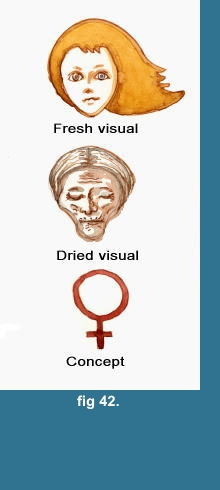
A fresh visual, C.R.Image"apple"
is dried to a dried visual, S.R.Image"apple".
The dried visual, S.R.Image still maintains
its shape, its individual appearance, though
it wrinkled. When the dried visual has been
completely dried, there will remain the fiber,
the nutritive substances. Those are ground
to the concept that has completely lost the
individual difference, and bottled with another
categorical concepts, sounds, touch, etc...,
labeled and stocked as the memory.
When Mr. Brain identifys a dried visual on
the show window of the visual shop as Mr.
Brain's memory, Mr. Brain just recognize
no more than his memory in storehouse, concept
about the dried visual, S.R.Image. So Mr.
Brain can quickly survey the situation, the
whole view of the show window. S.R.Image
may have much more plentful contents than
the memory. What we have to do about S.R.Image
is to confirm the out-line, concept.
Why do I insist on like that?
I cannot help supposing so, that we never have an image like a photo that
has equal denisty, equal resolution for every part, but we are constructing
for every moment a concentric image around the center image as C.R.Image
and the peripheral image as S.R.Image.
As a result, by compounding many concentric images like a montage image,
we may have a whole our image that has comparatively equal density for
each part.
But at every moment, I think we have a concentric image. The whole our
image are the image distributed concentric images.
Why?

Step 8-1-10
 he tale of Saint Jerome, his fame and his misery, additional explain
he tale of Saint Jerome, his fame and his misery, additional explain
I explain it by another expression.
Imagin, Saint Jerome who opened a door and has just steped into a room and shut the door behind his back.
As soon as he found out there a dog and a cat and a mouse and a big snail, another door suddenly opens and a lion is coming into.
Then, What should he do?
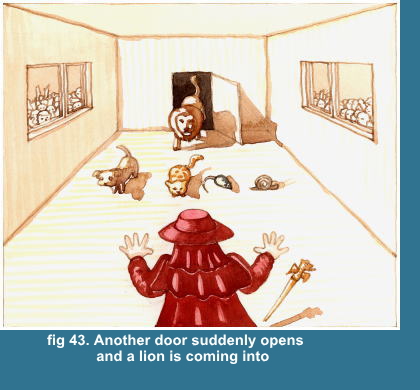
Firstly, he has to understand his situation. Needles to say, the lion is
most dangerous, but, hopely, it may be the lion that Saint Jerome had cured,
then it is like his friend, but at the same time it may be another, then
he may be eaten if it is hungry.
The door behind his back has shutted.
Various thoughts, emotions, expectations,
memories are coming and going like a furious
storm in his brain.
Indeed he was good-humored, until he entered
the room.
He was hearing behind his back people were astonished, admiring and finally saying "That's our Saint Jerome! I see him! Yes I see it! That's it!"
He well knows it and feels the people's enthusiasm, curiosity and reverence
without seeing them.
And he came into that room. He found there a dog and a cat, a mouse and
a big snail. Everything seemed to him remaining the same, peaceful and
calm, the dog and the cat don't querrel at all, the mouse and the snail,
both are friendly, he knew it at a glance and blessed them by its peacefulness...,
almost.
Then it came, he didn't expect it and was
upset so that the sight of the lion cause
him the horror made him almost screaming
and escaping from there, but he has had now
the dignity to keep to the people. That's
his crisis.
"I, I am the Saint Jerome! who has cured a lion. I have now the name.
It's impossible for me to easily escape from the situation, to abandon
everything, my property, my comfortable life and especially my fame.
I haven't still enjoyed enoughly my name.
I had been a wretched creature quite, wretched one, until the accident
had happened that I happened to bump on the very meek and fainthearted
lion in front of the witness, of the people, then I didn't have glasses, I was
so poor, I was walking bending down my head and thinking why I was so unlucky,
though I was endevouring and working hard,
"I am surely dying being poor, wretched and misery!
Why? Why The God!",
then I collided something, I did't know what it was but it seemed to be
a man of splendid body putting very rich fur on and a man of dignity,
at once I excused
"I, I am sorry sir! I, I didn't look forward at all"
and unintentionally offered my hand, then he put his hand on my offering
hand, as if it was the motion that well trained dog put the paw, was something
stuck in, I felt touching it and I pulled it.
"Oh! very rich glove!...it is?? But something sticking...sir?"
"Garuuu! Ugh! Ugh!"
"Ok! I pull out it, sir! for my apology,...Ha Ha! Now it's completely
OK! Pat! Pat! Good!"
I didn't understand it until the people yelled and applauded,
"Look at that! Look at that!, He is a man of bravery! He pulled the
thorn stuck in lion's paw!"
It was a lion, but meek and fainthearted.
The people didn't hear me apologizing to
a lion, for they were watching me around
far distance. But that has changed completely
my life.
Now I am never a wretcht creature but the Saint Jerome! I have now dressed
up with my favorite and very rich, the briliant red hat, cardinal's hat
and very rich the brilliant red frock, cardinal's frock.
I am always asking since that change, to a dog and a cat or a cow or a
flog or a worm, or a caterpillar, or,
or everything!, alomost every creatur!,
"You!!!, You know who I am? What I am?",
but I am never doing to the people, because I know well that people hate a man who is boasting his position, wealth, fame and privilege.
I know well that every media suddenly begins to strongly disappove that
by a mistake again and again on TV.
And I will be being disliked.
People won't fail to get revenge on that, if I had lost my privileg.
I never miss it.
I behave humblly but I am the Saint Jerome.
So instead of saying that, I show them My hat and mantle to those rude
fellows and children who don't know to show their respect for me.
Every place wherever I go, people see My hat and mantle of the Saint Jerome.
I have been rich, I have been fame, I have now dressed up and had glasses,
but I haven't enjoy my fame enough!
I know that the people crowd around the room outside, will laugh at me
and hate, if I was upset and screamed by the horror and escaped from it.
Everything comes to an end!
What's Expiration!
By a creature, a Lion, brought the begining!, shall bring the end to me!
To Stay or To Run away, Both are dangerous!
Bu,Buttt... there can be the possibility, that a lion now came in may be
the same lion, him, that I had cured, that I had left in my study today's
morning.
He might come in also for his business.
It isn't impossible!
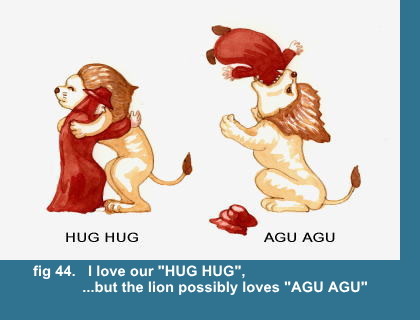
Then I only walk to him, offering my hands to him, pleasing our meeting
and doing "our Hug, Hug"
But I hate I can hardly distinguish it! his face from another lions', almost same for me! but I have to try it!...
B,But if it was another lion, it's, it's, it's dangerous!!!...I never want
to be eaten, it's my life, to escape is best,...Bu,Buttt!... media will
report that,.. It was the cheating that St. Jerome beat his breast by himself
with a rock in the desert!!!...
No!, I didn't didn't cheat,...the fact was that,...
That was just after the lion episode,
one reporter came for the coverage,
I said "Please wait for miniute while I just change my clothe"
"Oh! What's that bruises, Mr.Jerome!"...
"No. nO! Nothing! It's It's... a rock
hits my breast"
"beat? your breast!"
"...thrown by chil, chil,...dren...,
in the Desert...Park"
"in the desert!?"
"Don't mind it!" "No, No problem! Haha, Ha!"
"So, Mr. Jerome, you say you beat your
breast by a rock clasped in your right hand,
in the desert, Right? But, Mr. Jerome, Why
do you beat?"
"I was beeing tormented by...by...chil,...chil,...dren,
no, nothing, maybe hallucinations"
"Hallucination!!! you say you would
beat yourself until the Hallucinations passed!
Oh! Here is the real Saint! That's scoop!
That's News!! I will write it!!! Don't say
it to other reporters, Please! The headline
was completed! THE BRAVE MAN IN THE DESERT!!!"
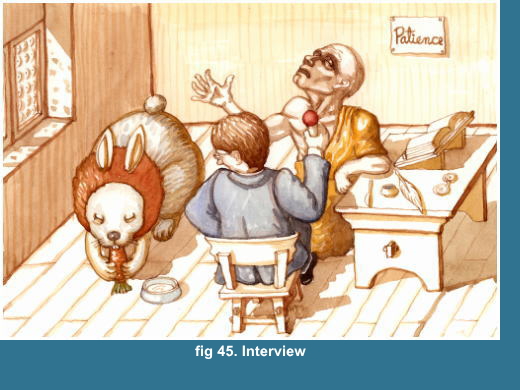
"Oh! Of course! I will never, never
say it again"
"By the way, Mr. Jerome! The lion is
very quiet and gentle, isn't it? like a rabbit!?!?"
"Of, Of course! I order him to keep
calm and he does so
side by me! I love it!"
"But,...He is eeeating carrots!!!???"
"Don't mind it! It's not healthy
to eat meat only"
"Oh! HaHaHa...???...OK! Bye now!"
Surely, I didn't want...Bu,Bu,Buttt,...why can I do such a thing, I am
now the man who has cured the lion, How?... that man!...can say?... that
children mistook me for a homeless!!! and threw rocks at me and hurted?
Then I was cured in a hospital, so there still remains my medical record.
If the record was leaked out by media,...they do it! they do it!
Surely, I had suddenly won fame on TV as the St. Jerome by that article,
and that same media kick me out completely,
like a drown wretched dog!
thrown me into a ditch mud!!!"
Oh My Poor Jerome!!!
He is at a crisis!!!
Those misery past and happy memories, expectations and thoughts have filled
up his brain at a moment and are going around and around by furious velocity.
He has to choice either to escape from there
at once and diprived his fame, or to stay
there to bet his life on a little possibility
of a lion for his established fame.
And he choiced to stay there, like a hopeless
man bets his dream on less hopelss fantasy.
Then what he has to do is to identify a lion.
To keep his fame or to lose depends on only
that point.
Then does he watchs carefully a big snail?
No!
Then a mouse?
No!
A cat? or a dog?
No!, No!
He must be watching a lion with all his nerves to identify like a frozen
man.
At the same time he has to expect the action,
if a lion was another lion and very starved.
He expects desparately the possible near furtures...
"A hugry lion will suddenly jump at and catch and tear and eat his
meal.
Which will be his foods?,
a big snail? is easy to catch, but a lion probably doesn't like it. If
he eat it, he has it for just an hors d'oeuvre.
A mouse? is too small for his appetite and
too trouble labour for his expected award.
A cat and dog may be worth of his main dish. But these creatures are unreasonable
fellows and suddenly ran away without any reason quickly from the lion,
left the big snail and me.
Oh! My! God! then the lion catchs me! but,...while they remains there between
the lion and me, I...can...be...safe?"
So I suppose he has to proceed the identification at the same time carefully watching the positon, a dog and cat and a mouse, not to be himself as the lion's meal.
He needs the details to identify his lion but needs not to examine those,
a dog and a cat and a mouse.
He may know about those fellows only that, a dog is still sitting between
the lion and me, a cat is still there right hand of the dog, and a mouse
also there right hand of the cat,
and the big snail can be ignored.
He probably needs not know, what kind of a dog, what color , how looking
and further informations about it.
For he is really busy to identify the lion only.
He will be proceeding the identification,
he will examine firstly the lion's paw where the wound by a thorn might
remain, and that is the dicisive evidence,
and he will glance at the dog's positon,
then the cat's,
then the mouse's,
and he will examine secondly the eyes of the lion
and glance at the dog's position,
the cat's,
the mouse again,
and he will examine thirdly the nose
and glance at their position by turns again,
and examine fourthly another part
and glance at the position,
again and again until the identification has finished.
He needs to be watching also the action of a dog and a cat and a mouse
while he is identifying the lion.
For, if the mouse suddenly began to run, then the cat would run after the mouse
and the dog might also run after the cat runing after the mouse, so there remains nobody between
the lion and him. If the lion run after them, then he has to quickly run away the room out as soon as he sees it.
Because the lion such that wants to eat a dog and a cat is never his lion,
meek and fainthearted, like to eat a carrot.
And if the lion doesn't run after them, then the expected state of the lion is that the lion may be his lion,
meek and fainthearted or just the lion doesn't be staved, or the lion wants to eat him, in either case, he had better to run away.
Namely, the dog and cat and mouse are the
important object as the diversification of
risks. He can proceed safely the identification
as long as they stay there as the diversification
of risks between the lion and him.
So he has to be watching their positions but he doesn't need to know further
informations about them.
In that situation,
the lion's image is fresh visual, C.R.Image.
He has to always re-read and re-write that image to identify by the lion's every detail.
The image of the dog, the cat and the mouse are dried visuals, S.R.Images.
He need not know them as no more than a conceptual "dog", abstract
"cat", mere a symbolic "mouse".
But he has to expect their near future actions, so he has to understand the relative behavior between a dog and a cat and a mouse
and to know their position and to know that it is "being a dog", "being a cat" and "being a mouse"
And the snail, Snail?...may only be remembered as it was once there, just at first once, probably it is still there, or isn't, both are not important for the situation.
Namely, we are moving always our eyes and looking around and at an object
by needs, so the objects that have little needs are scarcely looked at,
haven't naturally the details as the images but almost only the concepts.
We are recongnizing around the important objects, so we can survey the whole view very quickly how it is.
And the images except the important object that is always being quickly re-read and re-written, are almost our concepts and memories by our experience.
And the procedure of like that recognition may happen the cause of misunderstand,
hasty conclutions.
We see an object, but we find there only what we saw.
But, usually it is only that we don't recognize the existance of dried visual, S.R.Image.
Because as soon as we found that we didn't clearly see the object, then we have already seen clearly the object.
As soon as we have found to need to see clearly it, then the dried visual, S.R.Image has replaced with the fresh visual, C.R.Image at real time.
Oh! it was quite very "long and winding
road" for a mere explanation about a
painting!
I might have said too much irrelevant things,
so I have almost forgot what I had been explaining
about!
Why have I mentioned such the procedure of
the recognition about an image?
Again, above mentioned explanation has nothing
as scientific proof but my supposition.

Step 8-1-11
 n apple and a realism painting, additional explain for C.R.Image and S.R.Image
n apple and a realism painting, additional explain for C.R.Image and S.R.Image
As we don't buy what we don't need, we don't see what we don't need.
Correctly, as we buy only the goods as much as what we need within the limited expense for the priority, we see the objects as much as what we need within the limited time for the situation.
By the same reason, we apt to recognize or find no more element about an
object than what we have already recognized or found.
And that is usually mere the procedure of identification.
And the recognition, what we have already recognized is like a former mentioned dried viusal or our stocked memories, rather similar to a concept without the individual difference.
But nothing but that individual difference is important element for a realism painting.
And what we recognized as fresh visual is rather
temporary recognition, that will vanishes quickly, indeed that appears for a while to be filled
up with many details and contents. Certainly what we see as an image is
fresh visual.
What we usally call as a recognition is rather a dreid visual, or stocked
memories as a concept.
When we see an apple, then we are recognizing
it.
If we draw that apple, then, Which visual
does the drawing represent? Fresh visual
or Dried viusal?
If you are drawing a bit of one line by one line, observing and comparing
that apple and your drawing by turns, bit by bit, then the drawing represnts
faithfully that apple, so it must be similar to fresh visual, except the
technical cleverness of your hand.
Because you are to re-read and re-write your image a bit by bit. And that
means that there will be no room to draw that apple by your concept, stocked
memories, or dried visual. So the drawing will have to be similar to a
Fresh viusal.
Of course that means that the drawing will
be neither a photo like expression nor a
exact ratio, shape, but it will be not a
conceputual and it will faithfully represent
every details.
On the contrary, if you draw an apple by your memory without observing
and you hadn't had enough expericence about that, then the drawing may be no more
than a red color, ball shape with two dimples on the top with a stem and on the bottom.
That is nothing but a symbol to make understand what it is. It is the concept
by viusal exprssion, as it is the same function as a word, an apple.
But a realism painting isn't a symbol.
Our painting fluctuates between our visual
image on our retina and a symbol according
to the quality of our observation. We tend
to carelessly move our hand to draw an object,
and our hand is apt to automatically move.
I have the above mentioned fundamental understanding
of our recongnition about our viusal sensation
in our usual behaviour.
Namely, we don't carefully observe an object, unless we are faced with risky situation by the object like the lion of the tale of St. Jerome.
We tend to put aside an object as soon as we have only once recognized what it is, like the dog and cat and mouse and big snail.

Step 8-1-12
 e aren't carefully seeing in our usual demands, and we never
keep only for a moment our whole image like a photo, but we only suppose
so, and we are clearly seeing only small part every moment, additional
explain.
e aren't carefully seeing in our usual demands, and we never
keep only for a moment our whole image like a photo, but we only suppose
so, and we are clearly seeing only small part every moment, additional
explain.
As we can live without closely obsavation, then we don't carefully examine.
Usually we can talk sufficiently with the stereotype words, typical conversations, do with the recongnition as a symbol.
So we are carelessly apt to bring that usual behaviour to an art proceedrure.
The function of a viusal sensation may be enough for
our usual demands.
ut that isn't enough for the realism painting or a painting itself. For
the realism painting, we have to observe carefully an object like St. Jerome
has done to identy the lion.
Why can we understand a cartoon, simple drawing
as a person? It is that we don't usually
need to recongnize any more than a concept
about a person, as soon as we understand
what it is, then we stop observing and recognizing
it.
We usually see an object by that manner,
so we can understand a simple drawing as
a person, or a dog, or a cat. If we recognized
a simple drawing as a human fugure, then
that recognition will be completed by only
the confirmation about the contuor and the
parts, a head, two arms, two legs, two eyes,
a nose, a mouse and two ears and their relative
position without that details, materiality,
textures.
We don't usually metion the exactness of the shape, like a photography.
That is the recognition as Dried visual and as S.R.Image. And that is our
usual recognition about visual in daily life.
We once may recognize an object as Fresh
visual like a photo, that is a temporary
recognition at a moment, but the recognition,
Fresh visual will have quickly been Dried
visual and kept as rather conceputal image
with a few details, as soon as we look aside
and stop observing it.
And we have no more than the collections of Dried visuals, rather conceputal
recognition with a few detail as the whole image of our sight on our brain,
I suppose.
Everyone knows that we can't keep for long time the image filled up with
details, like a photo.
We never keep only for a moment our whole
view like a photo.
We only suppose so, that we keep a photo like whole view, correctly whole image.
But we don't know clearly whether it is or not. We can only have a photo
like image for limited, smaller view field for a moment. As soon as we
move our eye, look aside, then the former clear image can't be kept as
it had ever been so, but will change to a vague image, Dried visual.
We only suppose without any condition, any proof, any ground that the quality
of the clear image of smaller part may extend over the whole image.
Those state of our mind is happened by the easy understanding or conviction
about our recognition, "We are seeing clearly the whole view".
But the fact is that we can see clearly each limited part if we do it,
and we know extremely roughly what are there, but we don't know the details.
Because that knowledge about the visual is constituted by many recognition
about each object, what it is, the collection of Dried visuals, i.e. S.R.Image
and temporary recognition Fresh viusal, i.e. C.R.Image.
We only know what it was, more or less concept,
except what smaller part now we are really
carefully seeing. And that smaller part will
change quickly to the concept, leave there
no details for memory, as soon as we see
another part.
Again, the state that we are seeing means that we are seeing at a every moment the smaller part
and we know without clear images what were there, surroundings the smaller part.
And the smaller part is Fresh visual, C.R.Image. And the surroundings are
Dried visual, S.R.Image.
We can move quickly around our head and eyes to examine whole view. As
a result, we may get the clear whole view by montaging each part of Fresh
visual during the Fresh visual remains fresh, that may depends on our organs,
brain, physiological facluty like the phenomenon of afterimage.

Step 8-1-13
 windowpane, additional explain for C.R.Image and S.R.Image
windowpane, additional explain for C.R.Image and S.R.Image
By another expression,
Imagine a frosted windowpane!
If you wipe off the frost of a windowpane, then you can see clearly outside
view through the wiped part. The wiped part is Fresh visual, the others
are Dried visual.
If you leave that part not wiped again, then
that part will be frosted again, that means
that Fresh visual quickly changes to Dried
visual.
The state that we are seeing is that we are
always wiping another part by turns to see
clearly the out side view, and the already
wiped parts are gradually frosted again by
turns for the same order, unless we wiped
it off again.
As a result, we can keep cleanly whole windowpane, if we were always wiping
quickly off the frost.
But you may not sufficiently enjoy seeing the out side view, for you are too busy wiping off the frost to enjoy it.
So the state that we are seeing the whole view, like to see landscape is confined to get a general view.
That makes us appear the painting as a real
view, that appears very rough touch and expression
when we come nearby the painting.
By the way, I think you doubt of the existence
of my Fresh visual and Dried visual, C.R.Image
and S.R.Image. You say "But we really
see clearly the whole world?"
So I examined whether I can experiment to
confirm Fresh visual and Dried viusal or
not.

Step 8-1-14
 simple experiment for C.R.Imag and S.R.Image
simple experiment for C.R.Imag and S.R.Image
By this simple experiment, I am going to end those examination.
See by one eye the distant view, landscape to get a rid of the problem
of the focal depth, for we can focus on very limited depth for near view.
Really, the whole view appears clearly at first sight for me too!
When I continue fixing my eye on one object,
the clear view will be separating to the
Fresh visual and Dried visual, if my above
mention hypothesis is correct, or the acceptable
explanation.
I did it. Firstly I confirmed that my eye
was sooner dried than I confirm Dried visual...!!!
So I concluded that I can't continue to stare at one object without winks.
But I can fix my eye, view point on one object with winking.
It is difficult at first, but soon you can do it. And it's important not
to move your eye and to continue concentrating your attention on one object,
while you are observing, how does the surroundings appear?
I did it for the sight on the distance about
50m.
Certainly, when I did it, then I confirmed that center image appears clear
and the surrounding images appear much more vague than the center. The
center image seems to have the same quality as the usual image. The surroundings
seem not to have that details. And a man moving on the surroundings appears
very vague. I could find out just the color and the shape about his clothe
and his head and other parts of his body.
I couldn't do any details no more than that.
But, as soon as I move my eye aside, then
the vague image quickly turns to be clear
as the usual. You will confirm the same result.
Anyway, if you prepare the test chart like fig 46 ( next page )and experiment,
then you will be much more clearly confirme the state and quality of your
image.
The test chart is constiuted by the many different color bands of concentric circles and the characters of number or words.
The characters of number or words are regularly disposed on the different color band of the chart.
And only you do on that test is that you are telling the number or word from the center to peripheral along each radial direction, while you continue fixing your eye on the center.
However only you could recognize vaguely the shape, still you can easily
recognize the color bands of the chart, that certainly detamine the position
from center of the number or words that you see. If you can't tell the
number or word what it is, then it means that you can't clearly recognize
the object.
How about that?
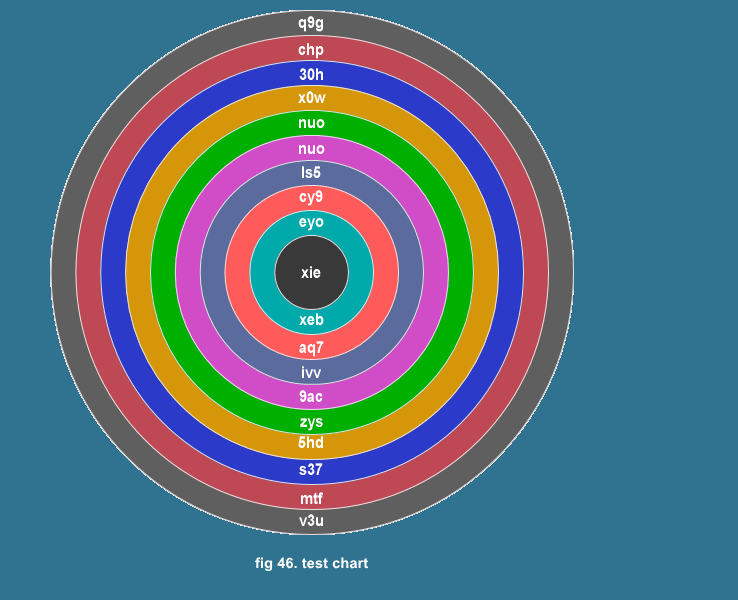 Attention! Don't stare it too long, harmful for you feeling.
Attention! Don't stare it too long, harmful for you feeling.
I did it. the characters in the center is readable, but I can't read the
ohter. And I found the color rings except the center Grey was soon fading
away as soon as I had concentrated on the center.
If you see it at the distance 38cm, then your visual field is 20 degree
by one eye.
It is well known anatomical fact that visual
cells concentrate on Macula and the image
on Macula is much more clearly seen.
And we know that we have the clear sight
as a central view field as I have mentioned
on the former page.
I don't know whether the above mentioned simple experiment corresponds
to that anatomical fact or not. And it's not my business.

Step 8-1-15
 mention again my conclusions about the recognition of the
whole image on our brain as our eyesight are below.
mention again my conclusions about the recognition of the
whole image on our brain as our eyesight are below.
I don't want to insist on my words, Fresh visual, Dried visual, C.R.Iamge
and S.R.Iamge and that aren't important.
The important thing is that at every moment we don't have the whole image
like a photo on our brain, on the contrary, at every moment we have the
clear center image and the vague surrounding image and we can make it certain
by the above mentioned simple experiment, still... we think,... or we always
don't doubt that we have the photo like whole image!!!
But we just have nothing but the whole image constructed by montaging each
momental images on the other momental images, once sensed images, once
was there, that we don't know exactly it now being there. And what gives
its the assurance are the resemblance, continuity, probablity, only our
experiences, I think so like a Hume.
We only suppose that the world that existed near past is the same world
is now existing after a while we had onece shut the eyes and the world
was existing while we had been shutting the eyes. And probably...it appears
being correct... because there...probably...won't happen any contradiction,...so
we think it right. Surely,... it doesn't cause any problem! And I don't
doubt...almost the existence too. ...But!,...Why can we believe the phenomenon
or existece of the out side of "my" ego?
It is a clever solution to put "Sein" against "Nicht"
like Hegel, but he only jumped over the crevasse without hesitation.
But this is quite philosophical problem,
however it is extremely interesting.
The whole image, world that we think we are seeing are the compounded image,
very very near past and present, memories and present, suppositions and
present, experiences and present, so I conclude.
I said on the method 5, book 7 that you have to be carefull of your knowledge
and that knowledge is sometimes to be an obstacle to the realistic expression, cause of the idealistic one, or the conceptual one.
Now I suppose you may understand why did I say so. We usally use our function about visual,
i.e. "to see" for only to recognize the concept of the object and that relation with the surroundings. And that functions are what I have explained on former page.
And we are careful about what it is, but we are usually indifferent about
how it appears on our retina.
But the important thing of an exact or realism painting is how it appears
on our retina.
Usually we stoped to see the apple when we recognized an apple as it was
an apple, because then we have understood what it is. It's enough to draw
a piece of cartoon. The cartoon of an apple is to explain what it is.
But as for an realism painting, It is too much common, or typical, or boring.
We don't need to observe an apple only to draw a concept of an apple.
So we have always to be asking to ourselves "Really are we drawing
what we are seeing?"
Especially when we start to draw the layer 2 and 1. (Oh! it's very long time since I lost that words)



 our elements that determine the nature of an object, the additional explain
our elements that determine the nature of an object, the additional explain he relation between the elements and the layers, additional explain
he relation between the elements and the layers, additional explain



 o depict layer 2, you need to be careful of the relation
between your stocked knowlegde and your observation
o depict layer 2, you need to be careful of the relation
between your stocked knowlegde and your observation hat kinds of memories am I able to suppose, that we have
for the stocked visual images in our brain?, additional explain and my
hypothesis
hat kinds of memories am I able to suppose, that we have
for the stocked visual images in our brain?, additional explain and my
hypothesis eally, What is it, our whole image in our brain as a eyesight?,
eally, What is it, our whole image in our brain as a eyesight?,  hy are we able to quickly recognize the whole visual field,
and why aren't we able to quickly read? , additional explain and my hypothesis.
hy are we able to quickly recognize the whole visual field,
and why aren't we able to quickly read? , additional explain and my hypothesis. y the quick recognition about the view and by the nature
of the images of our dream, I cannot help concluding that our images are
categorized for two kinds of image, that I name its, C.R.Image and S.R.Image,
additional explain and my hypothesis.
y the quick recognition about the view and by the nature
of the images of our dream, I cannot help concluding that our images are
categorized for two kinds of image, that I name its, C.R.Image and S.R.Image,
additional explain and my hypothesis. I suppose that C.R.Images and S.R.Images
are usually mixed up and construct the whole image. I mean, when we see a landscape, then each
C.R.Image and each S.R.Image are equally distributed in same density for
every part, like well mixed up one cup of the suger and coffee. Namely,
sometime C.R.Images are concentrated on an object and S.R.Images are on
the surroundings of the object, each may be separatedly distributed, especially
when we are fixing our eye on an object.
I suppose that C.R.Images and S.R.Images
are usually mixed up and construct the whole image. I mean, when we see a landscape, then each
C.R.Image and each S.R.Image are equally distributed in same density for
every part, like well mixed up one cup of the suger and coffee. Namely,
sometime C.R.Images are concentrated on an object and S.R.Images are on
the surroundings of the object, each may be separatedly distributed, especially
when we are fixing our eye on an object. think I need a supplementary explain about C.R.Image and
S.R.Image to avoid misunderstandings.
think I need a supplementary explain about C.R.Image and
S.R.Image to avoid misunderstandings. he tale of Mr. Brain and his C.R.Image & S.R.Image, additional
explain
he tale of Mr. Brain and his C.R.Image & S.R.Image, additional
explain A fresh visual, C.R.Image"apple"
is dried to a dried visual, S.R.Image"apple".
The dried visual, S.R.Image still maintains
its shape, its individual appearance, though
it wrinkled. When the dried visual has been
completely dried, there will remain the fiber,
the nutritive substances. Those are ground
to the concept that has completely lost the
individual difference, and bottled with another
categorical concepts, sounds, touch, etc...,
labeled and stocked as the memory.
A fresh visual, C.R.Image"apple"
is dried to a dried visual, S.R.Image"apple".
The dried visual, S.R.Image still maintains
its shape, its individual appearance, though
it wrinkled. When the dried visual has been
completely dried, there will remain the fiber,
the nutritive substances. Those are ground
to the concept that has completely lost the
individual difference, and bottled with another
categorical concepts, sounds, touch, etc...,
labeled and stocked as the memory. he tale of Saint Jerome, his fame and his misery, additional explain
he tale of Saint Jerome, his fame and his misery, additional explain Firstly, he has to understand his situation. Needles to say, the lion is
most dangerous, but, hopely, it may be the lion that Saint Jerome had cured,
then it is like his friend, but at the same time it may be another, then
he may be eaten if it is hungry.
Firstly, he has to understand his situation. Needles to say, the lion is
most dangerous, but, hopely, it may be the lion that Saint Jerome had cured,
then it is like his friend, but at the same time it may be another, then
he may be eaten if it is hungry. Then I only walk to him, offering my hands to him, pleasing our meeting
and doing "our Hug, Hug"
Then I only walk to him, offering my hands to him, pleasing our meeting
and doing "our Hug, Hug" "Oh! Of course! I will never, never
say it again"
"Oh! Of course! I will never, never
say it again" n apple and a realism painting, additional explain for C.R.Image and S.R.Image
n apple and a realism painting, additional explain for C.R.Image and S.R.Image e aren't carefully seeing in our usual demands, and we never
keep only for a moment our whole image like a photo, but we only suppose
so, and we are clearly seeing only small part every moment, additional
explain.
e aren't carefully seeing in our usual demands, and we never
keep only for a moment our whole image like a photo, but we only suppose
so, and we are clearly seeing only small part every moment, additional
explain. windowpane, additional explain for C.R.Image and S.R.Image
windowpane, additional explain for C.R.Image and S.R.Image simple experiment for C.R.Imag and S.R.Image
simple experiment for C.R.Imag and S.R.Image
 mention again my conclusions about the recognition of the
whole image on our brain as our eyesight are below.
mention again my conclusions about the recognition of the
whole image on our brain as our eyesight are below.